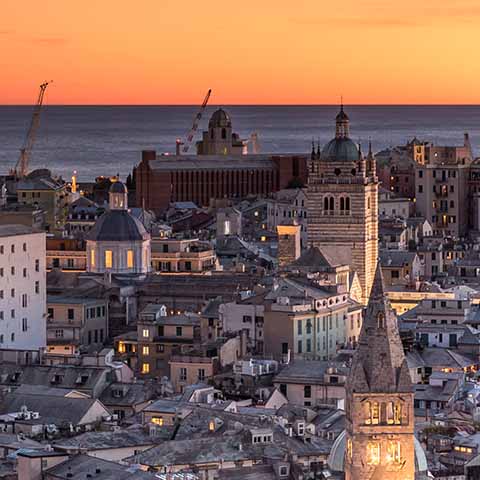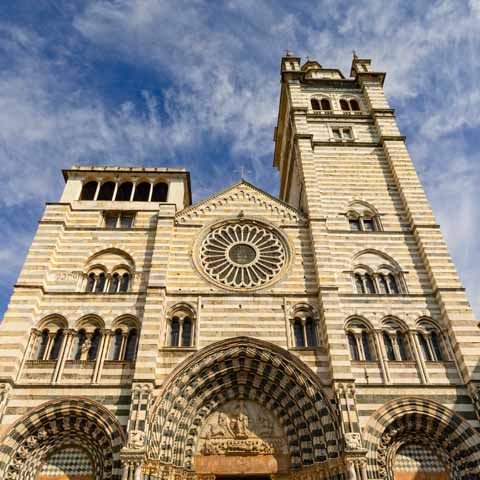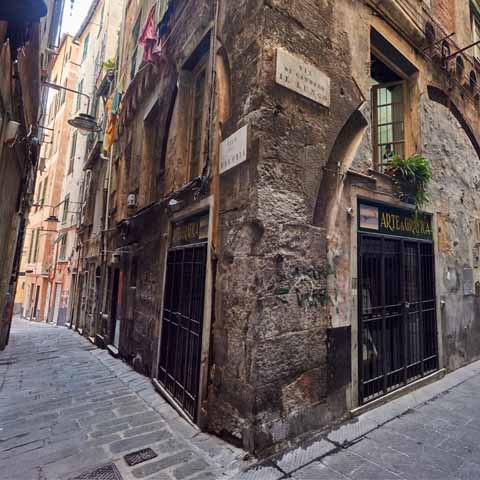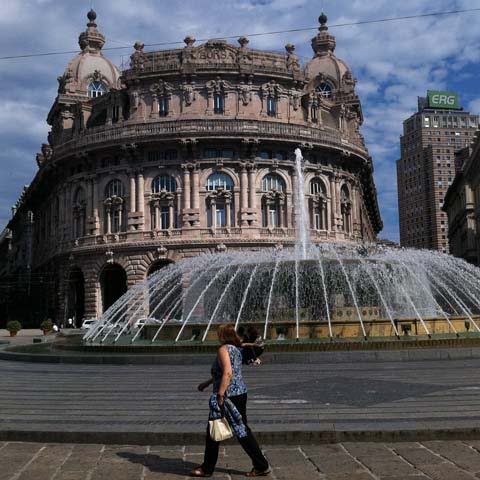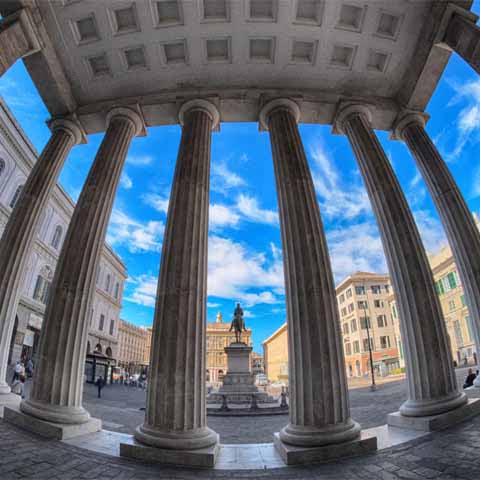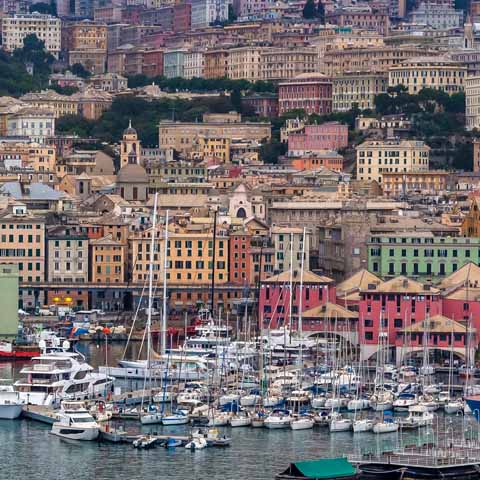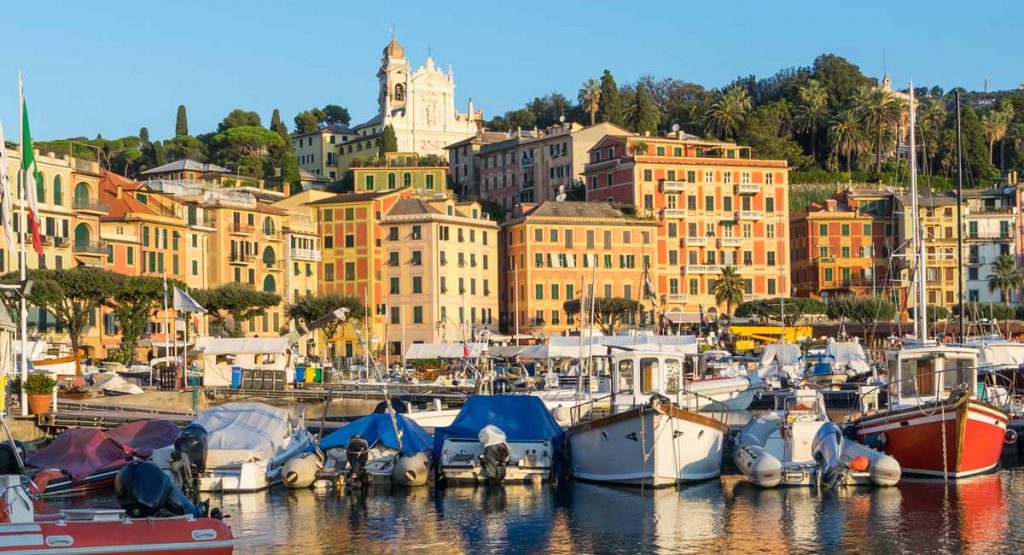Genoa is one of the most celebrated cities in Northern Italy, a large settlement located along the innermost part of the homonymous gulf. Flanked by the Apennines and deeply engraved by the Bisagno and Polcevera valleys, Genoa communicates with the Padania hinterland through an easily accessible pass.
This strategic position sheltered by both the mountain and the sea has conditioned the development of the city since ancient times, defining its mercantile vocation.
Today, Genoa is a vast industrial conurbation extending along the coastline of the Tyrrhenian Sea and connected with all main centers of Italy. Life in the city is undoubtedly linked to the port, established since the earliest times and expanded over the centuries to adapt to the new needs of an ever-growing movement of people and goods.
Being a university and bishopric center, Genoa also has an exciting history and boasts rich cultural remains that shaped the character of this city, which served as the center of a mighty Republic for seven centuries.
PREHISTORY OF GENOA
Genoa has an ancient, yet somehow obscure early history. The Ligurians were undoubtedly the first civilization to settle in the territory, and evidence shows it was already a thriving center in the fourth century BC.
The original settlement was destroyed by the Carthaginians in 205 BC, as a punishment for having allied with the Romans during the Punic Wars. Unfortunately, there is little evidence of Genoa’s structure prior to the tragic event.
With the expansion of the Roman Empire, Genoa became a Roman municipality and received its name, Genua.
HISTORY OF GENOA
The city became an episcopal seat in the third century AD, but the clerical power was smashed by the Goths. Nevertheless, the city recovered quickly, and after the Greek-Gothic war, it became the most important center in the region.
The clerical control turned its focus towards the city once more when in 569, Honoratus, the Bishop of Milan, found refuge in Genoa while fleeing the Lombards. Thus, Genoa became the Milanese episcopal center until 641 when Rothari, the King of the Lombards, conquered the city and named it the capital of the Duchy of Liguria.
After the conquest of the Franks in the following century, Genoa became a county. Towards the middle of the ninth century though, it was sacked by the Emperor Lothair I, who controlled it from 845 to 850.
This marked the incorporation of the city in the Obertenghi border district, but the exposed position acted as a magnet for the Saracens. Their raids pushed the municipality to build mighty city walls and a fortress meant to protect the bishop.
The emergence of the walls and the fortress caused the locals to acquire a strong citizen conscience. The Genoese population was now more determined than ever to preserve the integrity of their community and protect it from Saracen intrusions. As such, Genoa allied with Pisa in an attempt to drive the Saracens from Corsica and Sardinia.
The eleventh century found the city ruled by the ecclesiastic power, but the church did not oppress growth. On the contrary, citizens formed trade associations (compagnie) that joined together to form the Genoese government, which led to the birth of the city-state called Compagna Communis.
In the second half of the century, Genoa elected its first consuls, a measure that brought even more power to the municipality.
This marked the beginning of ambitious foreign policy, and the city contributed to the transport and provisioning of the first Crusaders, tying accords with numerous seaports and obtaining commercial privileges in the East.
At the same time, the city also imposed its supremacy on the Riviera, clashing with Pisa against which it fought for the possession of Corsica.
In 1158, the Genoese consul Caffaro di Rustico da Caschifellone obtained from Frederick Barbarossa the exemption of the city from the tribute and, three years later, the granting of gifts. But this period did not last long.
Genoa entered a new period of struggles against Pisa, which ended in 1175 with the precarious Peace of Pavia.
The political and economic ascent of the city and its defeat of external enemies also triggered new struggles between the Guelph and Ghibelline factions, which led to the appointment of a foreign mayor from Brescia in 1191.
The prevalence of the Guelphs resulted in a temporary return to the consular system, but Genoa refused to bow to Frederick II. Nevertheless, in a series of unfortunate events, Genoa’s fleet was defeated in 1241 near Giglio Island.
With a rich bourgeoisie pressing to gain more control over public affairs, the city obtained a new public figure and Capitano del popolo (Captain of the people) in Guglielmo Boccanegra. However, he was quickly forced to abdicate from his function by the nobles, and only Oberto Doria succeeded in imposing the authority of Captain of the people in 1270, undermining the power of the mayor.
At the same time, the affirmation of Genoa’s main rival, Venice, brought a period of decline which especially affected trade with the East. But the rise of the Latin Empire of Constantinople brought prosperity to Genoa again, thanks to the advantages obtained by the Emperor of the Byzantine Empire during the Treaty of Nymphaeum in 1261.
The new economic and administrative power strengthened Genoa’s position, giving it the means to engage in new battles against Pisa. Pisa lost the struggles in 1284 at Meloria and Genoa obtained supremacy over the Mediterranean, that it would now dispute with Venice.
The end of the century came with a victory for the city that also brought prosperity. But this victory was short-lived, as Genoa would soon start to deal with internal struggles between the Guelphs and the Ghibellines.
Despite the bourgeois trying to pacify the two factions with the creation of a doge and the exclusion of nobles from the government, the results were scarce.
The first Doge of Genoa was Simone Boccanegra, named in 1339 and forced to resign after a mere six years due to continuing conflicts.
These internal struggles caught the attention of Milan and France, who, tempted by a weakened Genoa, started to fight for supremacy, and during the French period, the Bank of San Giorgio was established.
After a hasted political decline of the Ligurian city, Genoa resumed the conflict with Venice, and after long years of struggles, the city passed to Theodore II, Marquis of Monferrat, who imposed a series of doges unable to exert real power.
In 1421, Genoa and the entire Liguria region passed under the Duchy of Filippo Maria Visconti, but a revolt in 1436 entrusted the city to the so-called Capitani di Libertà, or Captains of liberty and resumed the election of the doges.
These events threw Genoa into a confused period of conspiracies and rebellions at an internal level, while externally, the Republic of Genoa lost almost all its colonies in the East and its coastal centers.
The middle of the century brought Charles VI of France to the area. The city fought him and knew a brief period of freedom, after which Genoa succumbed to the House of Sforza, the Dukes of Milan, then once again to France.
Weakened and involved in the struggles between Spain and France for dominance in Italy, Genoa was sacked by the imperial forces of Prospero Colonna in 1522 and was on the verge of losing its authority permanently, crushed by the two rival powers.
Luckily though, the admiral Andrea Doria succeeded in saving Genoa from danger, obtaining its recognition of autonomy in 1528.
Genoa achieved a new constitution that granted the nobility almost all power. Even so, the city found its peace, at least for a time.
Unhappy with the new orders, once the colonies had been lost and the trade greatly reduced, the city once again struggled during the Gianluigi Fieschi Conspiracy against Andrea Doria, which was ultimately unsuccessful, and the uprising of Sampiero d’Omano da Bastelica in Corsica, events that triggered fierce battles between the old and new nobles.
The seventeenth century brought further decline. With the deviation of trade flows to America, Genoa found itself dried up of many resources, and the city lost most of its strength. Taking advantage of the situation, the Dukes of Savoy tried to gain control over the port during the Valtellina War but failed miserably.
Instead, Louis XIV of France succeeded in subduing Genoa after attacking it in May 1684, forcing the doge to accept a sort of protectorate, which in reality was rather onerous. A subsequent Austrian domination brought some moments of glory, but the city quickly entered in the orbit of France once again.
After futile attempts to remain neutral during the French Revolution, the city was forced to welcome the Napoleonic army in 1796, transforming itself in the following year into a democratic and Jacobin republic.
Between April and June of 1800, under the orders of General André Masséna, Genoa supported the siege of the Austro-Russian troops which ended with Napoleon’s victory at Marengo.
Five years later, the Republic of Genoa became an integral part of the French Empire, and after the Congress of Vienna, it was assigned to the Kingdom of Sardinia. The decision was fiercely opposed by the Genoese people, but the events actually brought economic renewal by favoring communication with a large and safe hinterland.
The revolutionary propaganda during the Risorgimento caused conspirators and patriots to organize uprisings, but also gave considerable contributions to the monarchist-constitutional cause.
Once united with the Kingdom of Italy, the history of Genoa merges with the history of the other adjacent regions.
During World War II, Genoa was subject to numerous bombings that caused serious damage to the port and inhabited areas. A very active center for partisan organizations, Genoa was among the Italian cities to revolt against the Nazi and Fascist parties. These efforts won Genoa a Resistance gold medal of military valor in recognition of the sacrifices of the local population.
After the war, Genoa was an important driver of Italy’s economic recovery and became part of Northern Italy’s manufacturing triangle together with Milan and Turin. During this period, the city expanded greatly.
In 1992, much of Genoa’s city center was restored and revitalized in honor of the Genoa Expo ’92, which celebrated the 500th anniversary of Columbus’s voyage to America. Areas such as the Old Port were renovated and updated with modern buildings, including the Aquarium designed by Renzo Piano.
Today, Genoa is still among Italy’s most important commercial shipping centers. In recent years, as a result of the city’s cultural wealth, Genoa has begun to attract more international travelers eager to explore its elegant palaces and rich museums. The city also serves as a gateway to the rest of the scenic Liguria region.
ARCHAEOLOGY IN GENOA
The area surrounding Genoa was inhabited since the pre-Roman times, as is evidenced by findings dating back to the sixth century BC. A vast necropolis dated between the eighth and fifth century BC was also brought to light during excavations on the hill of Sant’Andrea, at the beginning of the last century.
Some of the first city walls dating from the fifth century AD can still be seen scattered around the city, while traces of the Roman municipium are also clearly visible.
Perhaps the most noteworthy remains from the Roman Era are those around via San Lorenzo, which show the orthogonal plan of the city.
The medieval settlement developed above the Roman one and expanded considerably thanks to the commercial relations Genoa had at the time. From the ninth and tenth centuries, there are still visible traces of the first medieval wall enclosure that was rebuilt in 1155.
Besides numerous open-air sites showing evidence of the passage of the Ligurians, Genoa also counts multiple archaeological and ethnographic museums which house further archaeological evidence retrieved in the region.
The Archaeological Museum of Genoa features many artifacts belonging to the protohistory and prehistory of the city. The Paleolithic tombs of Grotta delle Arene Candide and the rich pre-Roman necropolis of Genoa are administered by the museum and hold numerous traces of the various populations.
The Diocesan Museum of Genoa is also noteworthy from an archaeological point of view. Here, are housed numerous artifacts found during excavations carried out by the Archaeological Superintendent of Liguria, including the remains of an ancient Domus, a decorated bone comb, and multiple ceramics that are undoubtedly worth admiring.
Don't just see Italy, live it.
Your dream trip to Italy has never been closer
No more endlessly scrolling travel sites. Our travel experts will craft the perfect, one-of-a-kind trip just for you.

300+
DESTINATIONS
We offer more Italian destinations than any travel site. Do and see more with Trips 2 Italy.
1 (of a kind)
ITINERARIES
Because your dream trip to Italy should be designed for you, not for the masses.
100%
PEACE OF MIND
From flights and accommodations, to food and activities - we take care of every detail.
